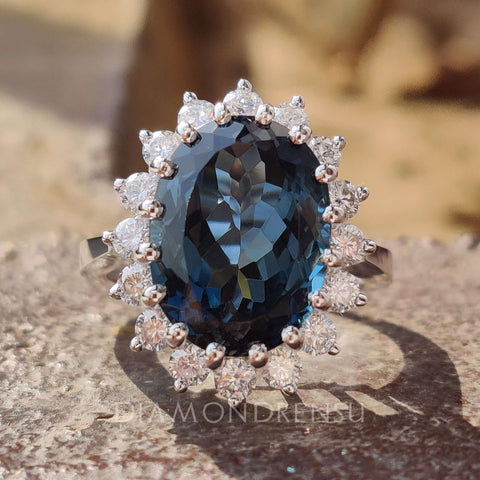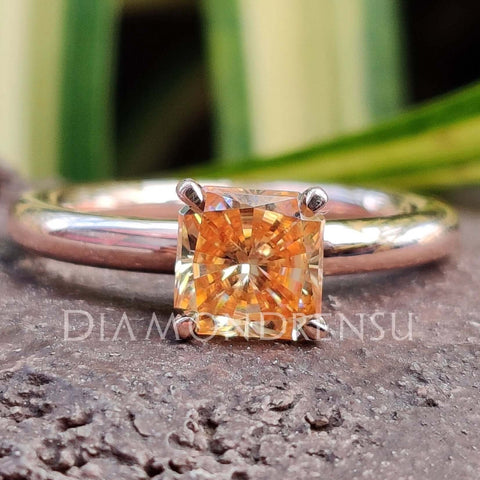Morganite is a popular gemstone known for its enchanting pink hue and its durability. As a variety of the mineral beryl, it shares many properties with its more famous siblings such as emerald and aquamarine. One key property that sets morganite apart is its hardness, which plays a vital role in determining its suitability for use in jewelry and various applications.
Table Of Contents
When assessing the hardness of morganite, we refer to the Mohs hardness scale, a widely accepted classification of minerals based on their scratch resistance. Ranging from 1 (softest) to 10 (hardest), the Mohs scale offers valuable insights into the properties of gemstones. Morganite, like its fellow beryl family members, boasts a hardness between 7.5 and 8 on the Mohs scale, making it a durable and resistant gemstone perfect for use in jewelry designs.
Understanding the hardness of morganite is essential because it directly impacts the gemstone's practicality and long-term wear. Its relatively high hardness on the Mohs scale ensures that morganite can be worn in everyday jewelry pieces without easily succumbing to scratches or damage. This durability, combined with its captivating color, has made morganite a popular choice for engagement rings and other fine jewelry.
Basics of Morganite
Morganite is a beautiful gemstone, known for its stunning range of colors, including pink, rose, orange, salmon, peach, yellow, and pastel tones. As a member of the beryl family, morganite shares some similarities with other well-known gemstones like emerald and aquamarine. In this section, we will provide an overview of morganite's characteristics and its position on the Mohs hardness scale.
Morganite is a rare gemstone, with its appealing colors and relative scarcity making it highly desirable among collectors. A primary factor contributing to morganite's unique hues is the presence of trace amounts of lithium and manganese. The subtle pastel shades of morganite are often associated with the heart chakra and are thought to bring emotional healing and balance.
One of the most essential characteristics of gemstones is their hardness, as it indicates the level of scratch resistance and overall durability of the stone. The Mohs hardness scale, developed by Friedrich Mohs in 1812, is the most widely used method for determining the hardness of minerals. This scale ranges from 1 (the softest) to 10 (the hardest).
Morganite, being a beryl mineral, has a good level of hardness, scoring between 7.5 and 8 on the Mohs hardness scale. This makes it suitable for use in various types of jewelry, such as rings, necklaces, bracelets, and earrings. However, despite its durability, it's crucial to treat morganite with care, ensuring it's well-protected from potential damage due to daily wear and tear.
In addition to its appealing colors and hardness, morganite possesses other appealing properties. For starters, it's quite transparent, allowing light to pass through the crystal and giving it an enchanting sparkle. Furthermore, morganite can be cut into various shapes, such as round, oval, cushion, and emerald, which showcases the gem's beauty and elegance.
In conclusion, morganite is a truly captivating gemstone with a range of mesmerizing colors, good hardness, and exceptional transparency. Its suitability for a variety of jewelry types and the mystical association with the heart chakra makes it a highly sought-after option for both collectors and those looking to add a touch of grace and serenity to their lives.
Morganite Origins

Morganite, a beautiful pink to peach-colored gemstone, can be found in various locations around the world. In our search for knowledge about this enchanting gem, we've discovered that some of the most significant sources include Brazil, Madagascar, Mozambique, Namibia, California, Maine, and Afghanistan.
Our journey begins in Brazil, a country known for its abundant and diverse gem deposits. More specifically, excellent quality morganites have been discovered in the Minas Gerais region. These gems often showcase vibrant colors and impressive sizes, making them highly sought after by collectors and enthusiasts alike.
Madagascar also offers us an important source of morganite. The island's renowned gem deposits have produced numerous beautiful specimens that are highly prized in the market. Like in Brazil, the morganite crystals found in Madagascar often display a rich, saturated color.
Moving across the ocean to Mozambique, we find yet another significant source of morganite. These African gems are often characterized by their bright pink or peach hues, which can be attributed to the presence of trace elements like lithium and manganese
Morganite in Jewelry
Morganite is a beautiful gemstone that has gained popularity in the jewelry world. Its attractive colors range from pale pink to a vibrant peach, making it a versatile choice for various jewelry designs. As a member of the beryl family, morganite shares traits with other well-known gemstones such as emerald and aquamarine. In this section, we will discuss the factors that make morganite a suitable choice for jewelry.
The cut of a morganite gemstone plays a significant role in its visual appeal. A well-cut morganite can emphasize its pleasant hues and display optimal brilliance. There are numerous cuts available, including classic shapes like oval or round, as well as more intricate designs such as cushion or pear. A skilled lapidary can even create custom cuts to showcase the gemstone's best features.
Carat weight is another essential aspect to consider when selecting a morganite gemstone for jewelry. As morganite occurs in large crystals, it is common to find them in varying carat weights. Heavier stones might be more appropriate for statement pieces such as cocktail rings or pendants, while smaller carat weights are ideal for dainty earrings or stacking rings.
Morganite has a good hardness rating on the Mohs scale, typically between 7.5 to 8, which contributes to its wearability in everyday jewelry. This hardness provides a decent level of scratch resistance and durability necessary for various types of jewelry settings. However, care should still be taken to protect your morganite pieces from excessive impact or rough handling.
The refractive index of morganite also makes it an attractive choice for jewelry. A higher refractive index results in better light dispersion and sparkle within the gemstone. Morganite has a refractive index of approximately 1.58 to 1.59, allowing it to produce an elegant shimmer that can enhance any piece of jewelry.
Clarity is another crucial factor when choosing a morganite for your jewelry. As morganite generally has fewer inclusions than other gemstones, it is quite common to find eye-clean specimens. Faceted morganite gemstones are a popular choice for settings that highlight the stone's clarity and brilliance.
In summary, morganite's appealing colors, good wearability, and beautiful sparkle make it a popular choice for jewelry designs. Its wide range of cuts, carat weights, and clarity options allows for a diverse array of stunning pieces suited for jewelry aficionados and gem collectors alike.
Hardness and Durability of Morganite
| Property | Morganite |
|---|---|
| Hardness (Mohs Scale) | 7.5 - 8 |
| Durability | Moderate to good |
| Wear Resistance | Avoid exposure to harsh chemicals and abrasives |
| Care | Gentle cleaning with mild soap and warm water |
| Usage | Best suited for jewelry worn with care |
Morganite is a beautiful gemstone belonging to the beryl family, which also includes well-known gems such as emerald and aquamarine. One of the essential factors in determining the value of a gemstone is its hardness and durability. In this section, we will discuss the hardness and durability of morganite and explain its position on the Mohs hardness scale.
The Mohs hardness scale is a standard scale used to measure the mineral hardness of various gemstones. The scale ranges from 1 (softest) to 10 (hardest), with diamond holding the highest position. Morganite has a Mohs hardness of 7.5 to 8, which makes it a durable gemstone suitable for daily wear jewelry such as rings, earrings, and necklaces.
The hardness of morganite ensures that it can resist scratching and routine wear when in contact with other materials. However, it is always advisable to exercise caution and avoid situations where the gemstone could face a hard impact, as no gemstone is immune to chipping or breaking under extreme conditions.
In addition to its impressive hardness, morganite also exhibits a fair level of toughness. Although not as tough as diamond or corundum gems like sapphire and ruby, morganite's durability makes it suitable for various types of jewelry.
To summarize, morganite's position on the Mohs hardness scale, combined with its reasonable durability, makes it a reliable choice for those seeking a beautiful and long-lasting gemstone. While it may not be as hard as some other popular gemstones, with proper care and consideration, morganite can still provide its wearer with lasting beauty and enjoyment.
Comparison to Other Gemstones

When examining the hardness of various gemstones, it's essential to understand the Mohs scale. This relative hardness scale allows us to compare gemstones and determine which ones are harder than others. Let's take a closer look at how morganite stacks up against other popular gemstones.
Morganite is a member of the beryl family, which also includes emerald, aquamarine, and heliodor. It has a hardness of 7.5 to 8 on the Mohs scale, making it a durable and relatively scratch-resistant gemstone. In comparison, other beryl varieties have similar hardness levels, with emeralds and aquamarines ranging from 7.5 to 8, and heliodors coming in at around 7.5.
Some other notable gemstones with similar hardness include amethyst and kunzite, both of which also fall within the 7 to 8 range. These gemstones are considered suitable for use in everyday jewelry due to their durability and resistance to scratches.
If we move toward the higher end of the Mohs scale, we find corundum, which includes both sapphire and ruby, boasting a hardness of 9. This makes these gemstones even more scratch-resistant and durable than morganite and other beryl varieties.
On the other hand, some softer gemstones, such as pearls and opals, have considerably lower hardness ratings. Pearls have a Mohs hardness of 2.5 to 4.5, while opals range from 5.5 to 6.5. These gemstones require more care, as they are more prone to scratches and damage in comparison to morganite and other higher-ranked gemstones.
Lastly, it is important to mention diamonds, which are the hardest gemstones with a Mohs hardness of 10. Diamonds are renowned for their durability and scratch resistance, making them a popular choice for engagement rings and other jewelry that needs to withstand daily wear.
In conclusion, morganite holds a respectable position in terms of hardness among gemstones. Its durability makes it a popular choice for jewelry pieces that are meant to be worn regularly. While it's not as hard as corundum or diamond, it still compares favorably to many other beautiful gemstones like emerald, aquamarine, amethyst, and kunzite.
Care and Cleaning of Morganite

Morganite is a beautiful gemstone with a hardness of 7.5 to 8 on the Mohs scale. This makes it a fairly durable gem for everyday wear. However, taking proper care and cleaning it regularly can ensure that it maintains its brilliance for years to come.
When it comes to cleaning morganite, we recommend using a gentle approach. A soft toothbrush and warm, soapy water are all you need to remove dirt and grime from your morganite's surface. Gently scrub the gemstone and setting, then rinse it thoroughly with lukewarm water. Make sure to dry the piece with a soft, lint-free cloth to avoid any water spots or streaks.
It's important to be aware of morganite's stability when it comes to chemicals and other substances. We advise against exposing your morganite to harsh chemicals, such as household cleaning solutions, as they may cause damage to the gemstone. If you're unsure whether a cleaning product is safe for your morganite, it's best to err on the side of caution and refrain from using it.
While some gemstones can be safely cleaned using an ultrasonic cleaner, we recommend avoiding this method for morganite. Due to its composition and structure, morganite may be sensitive to the intense vibrations and high temperatures generated by ultrasonic cleaning machines. Instead, stick to gentle, manual cleaning to keep your morganite looking its best.
To ensure the lasting beauty of your morganite, store it carefully when not in use. We suggest keeping your morganite jewelry separate from other pieces to prevent scratches or damage from contact. A soft pouch or designated compartment in your jewelry box is an ideal solution.
By following these care and cleaning guidelines, you can keep your morganite gemstone looking stunning and preserve its natural beauty for years to come.
The Value of Morganite

Morganite is a popular gemstone known for its attractive pink to peach hues. This beautiful gemstone is valued for its excellent color, durability, and limited availability. Morganite ranks 7.5 to 8 on the Mohs hardness scale, making it a durable choice for jewelry and suitable for everyday wear.
The value of morganite is determined by a few factors, such as the size, color, clarity, and rarity of the gemstone. We find that the more vivid the pink or peach color, the higher its value. For instance, a larger morganite with a deep pink hue and exceptional clarity is considered more valuable than a smaller, less vibrant stone. However, the overall value of morganite is relatively affordable compared to other gemstones like diamonds, rubies, or emeralds.
Rarity also plays a role in the value of morganite. While morganite is not as rare as some other gemstones, it is also not abundantly available. This limited supply boosts its desirability and value. Morganite is primarily found in countries like Brazil, Madagascar, Mozambique, and Afghanistan, with each location producing gems of varying color and quality.
In conclusion, the value of morganite is influenced by its eye-catching color, hardness, limited availability, and rarity. It provides a beautiful and cost-effective alternative to more expensive gemstones for those who appreciate its delicate hues and unique properties.
Additional Facts about Morganite
| Fact | Details |
|---|---|
| Mineral Composition | Beryl family, same as emerald and aquamarine |
| Color Range | Pink, peach, salmon, and other pastel shades |
| Hardness (Mohs Scale) | 7.5 - 8 |
| Origin | Primarily found in Madagascar, Brazil, Afghanistan |
| Market Availability | Increasing popularity, available in various jewelry pieces |
| Metaphysical Properties | Associated with love, compassion, and emotional healing |
In this section, we will discuss some interesting facts about morganite, its inclusions, treatments, and physical properties such as specific gravity, birefringence, and refraction.
Morganite is a pink to orange-pink variety of beryl, a mineral species that includes aquamarine and emerald. As with other gemstones, certain inclusions can be found in morganite crystals. Inclusions are tiny particles, liquids, or gases trapped within crystals during their formation. These inclusions can be classified into liquid inclusions, multiphase inclusions, and fractures.
One of the interesting discoveries in morganite is the presence of hambergite-rich melt inclusions found in morganite crystals from the Muiane pegmatite in Mozambique. This finding helps to understand the paragenesis and formation conditions of hambergite in the pegmatite environment source.
When it comes to the physical properties of morganite, its specific gravity ranges from 2.72 to 2.90 g/cm³. The specific gravity is an important property that helps gemologists differentiate it from other similar gemstones. In addition, morganite exhibits birefringence, which is a measure of how light is split into two different refractive indices when passing through the gemstone. In morganite, birefringence typically ranges from 0.004 to 0.008.
Morganite's refraction is another aspect to consider. Refraction is the bending of light as it passes from one medium to another. The refractive index of morganite ranges between 1.57 and 1.60. It helps us better understand the optical properties of the gemstone.
Treatments, such as heat treatment, are often applied to morganite to improve its color and appearance. Heat treatment involves heating the gemstone at high temperatures to remove iron impurities and enhance the pink color caused by manganese and cesium ions within the crystal lattice.
In conclusion, morganite is a fascinating gemstone with unique properties and inclusions. Its inclusions, specific gravity, birefringence, and refraction play important roles in understanding not only the gemstone itself but also the geological conditions in which it formed. With its potential for treatments and enhancements, morganite continues to captivate those in the world of gemology.
Historical Aspects of Morganite

Morganite, also known as pink beryl or rose beryl, has a unique history and connection to the world of gemstones. Discovered in the early 20th century, this beautiful pink gemstone was named in honor of the famous American financier and gem collector, J.P. Morgan. Morgan's passion for gemstones contributed significantly to the popularization of morganite as a sought-after gem.
The first recorded discovery of morganite took place in Madagascar in 1910, but since then, it has been found in various locations around the world, including Brazil, Afghanistan, and the United States. The attractive pink hue of morganite results from the presence of manganese ions within the mineral's structure, and it can range from pale pink to deep rose in color.
When it comes to the hardness of morganite, it belongs to the beryl family and shares several properties with other beryl gemstones, such as emerald and aquamarine. On the Mohs scale of hardness, which was developed by the German geologist Friedrich Mohs, morganite scores between 7.5 and 8. This makes it a durable gemstone suitable for use in various types of jewelry.
We find it fascinating that the history of morganite intertwines with the story of J.P. Morgan, a man who made an impact not only on the world of finance but also on our appreciation for gemstones. The recognition of morganite's beauty combined with its durability and unique place in the history of gemstones makes it an increasingly popular choice for collectors and jewelry enthusiasts.
Also Read
Morganite and Healing
As we explore the world of gemstones, we often come across unique minerals with remarkable properties. One such gemstone is morganite, which has gained considerable attention for its association with healing and the heart chakra. In this section, we will delve into the fascinating aspects of morganite's hardness scale and its potential healing properties.
Morganite, a beryllium aluminum silicate mineral, is well-known for its pleasing pale pink to peach color. Its appearance and durability make it an ideal choice for jewelry. Speaking of durability, the hardness of morganite is measured using the Mohs scale of mineral hardness. Named after Friedrich Mohs, a German inventor, the scale provides a relative hardness comparison for various minerals. On this scale, morganite has a hardness rating of 7.5 to 8, making it a relatively tough and scratch-resistant gemstone. This resilience implies that morganite can retain its beauty and integrity for generations, making it an excellent choice for those seeking healing stones.
In terms of healing properties, morganite is often called the heart chakra stone. The heart chakra, also known as Anahata, is the fourth primary chakra in our body. It is responsible for governing love, compassion, and relationships. We believe morganite can help open and balance the heart chakra, allowing us to receive and give emotional healing. Working with morganite may bring relief from emotional distress, and promote feelings of inner peace, self-love, and acceptance.
Furthermore, morganite is said to hold the promise of strengthening our relationships, fostering compassion and understanding. By harmonizing our emotional state and helping to release past traumas, morganite offers a path toward more nurturing and genuine connections with others. It stimulates, not only our emotional heart, but also our intellectual capacities, which may foster inner wisdom and strengthen our ability to express love thoughtfully.
So, when considering the aspects of morganite's hardness and its potential healing properties, we can appreciate the balance it offers. From its physical resilience to the emotional and spiritual support it provides, this extraordinary gemstone holds a special place in the world of crystals. With profound connections to love and the heart chakra, morganite is a beautiful symbol of hope, healing, and emotional growth for those who choose to embrace its energy.
Frequently Asked Questions
What is the hardness of morganite on the Mohs scale?
Morganite, a variety of beryl, has a hardness of 7.5 to 8 on the Mohs scale. This scale measures the relative hardness of minerals and gemstones, with 10 being the hardest (diamond) and 1 being the softest (talc).
How does morganite compare to diamond in terms of hardness?
While morganite is a relatively hard gemstone, it doesn't compare to the hardness of a diamond, which is a 10 on the Mohs scale. Morganite's hardness of 7.5 to 8 means it is more susceptible to scratches and abrasions compared to a diamond.
Is morganite suitable for an engagement ring due to its hardness?
Morganite's hardness makes it a suitable option for an engagement ring because it is reasonably resistant to scratches and everyday wear. However, it is still not as durable as a diamond, so proper care and maintenance will be important to keep the morganite looking its best.
How does morganite rank alongside other gemstones like emerald and amethyst on the Mohs scale?
Morganite, like other varieties of beryl such as emerald and aquamarine, has a similar hardness rating of 7.5 to 8 on the Mohs scale. Amethyst, a variety of quartz, has a slightly lower hardness of 7. This means that morganite is somewhat harder than amethyst and similar in hardness to emerald.
What factors affect the durability of morganite in jewelry?
The durability of morganite in jewelry depends on its hardness as well as how well it is cared for. To maintain its luster and reduce the chance of scratches, we recommend avoiding exposure to harsh chemicals, extreme temperatures, and excessive vibrations or impact. A protective setting for the morganite stone, such as a bezel or half-bezel, can also help protect it from damage.
Does morganite have a greater risk of getting scratched compared to other gemstones?
Morganite has a lower hardness than diamond, sapphire, and ruby, so it is more susceptible to scratches compared to these harder gemstones. That being said, it is still a reasonably hard gemstone and ranks similarly to emerald. Taking proper care of the morganite and protecting it in the jewelry setting will help minimize the risk of scratches and keep it looking its best.
Checkout some of our top collections:


















